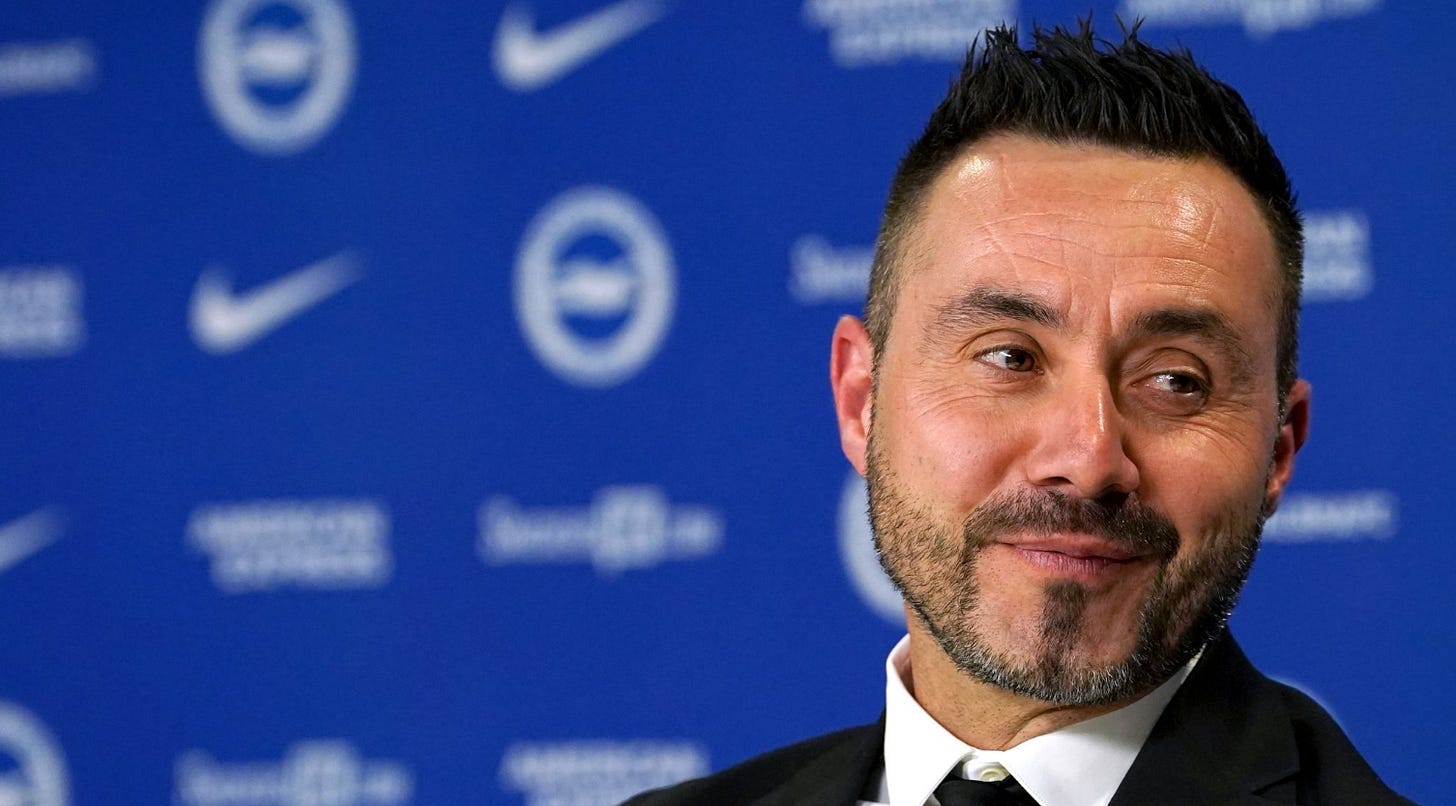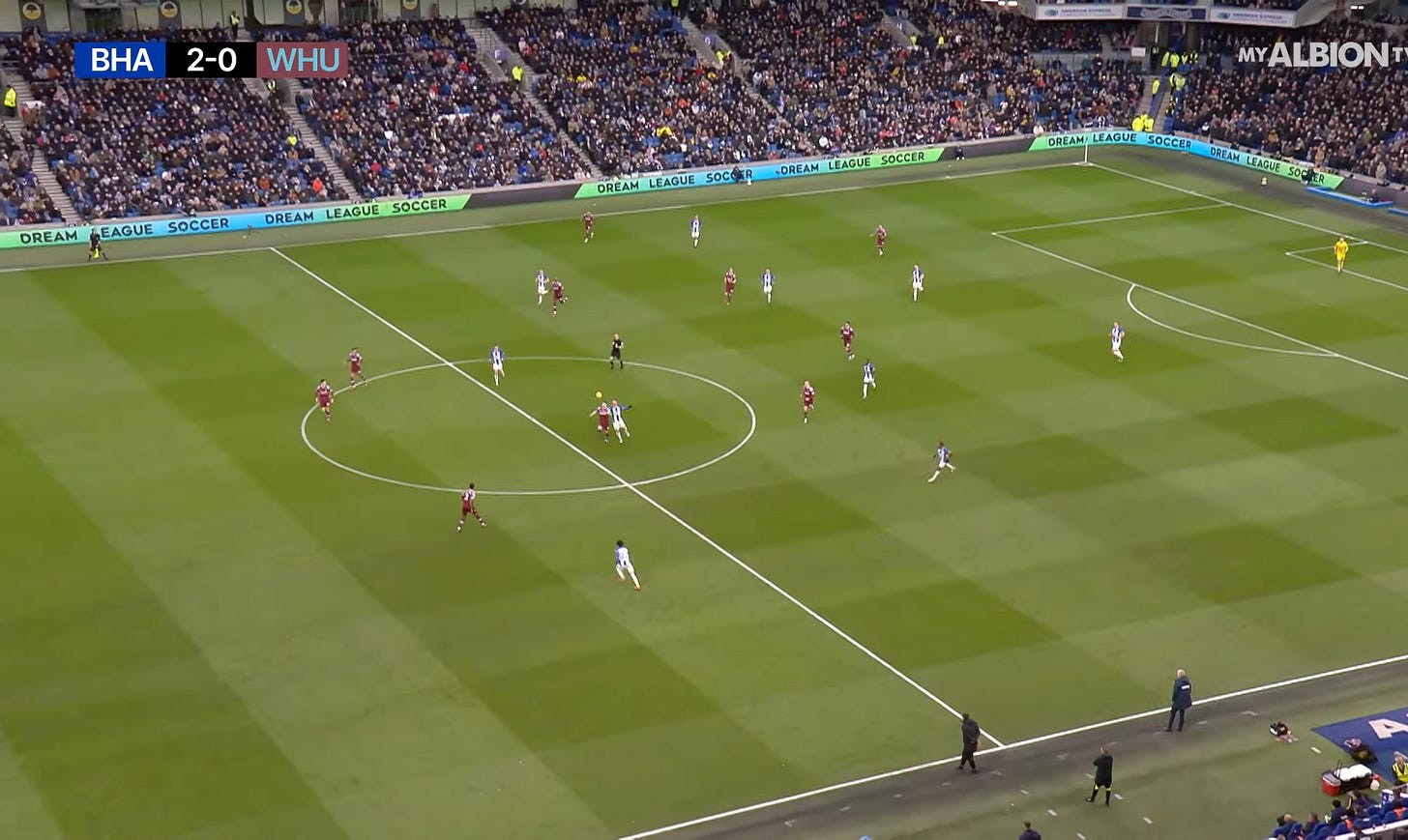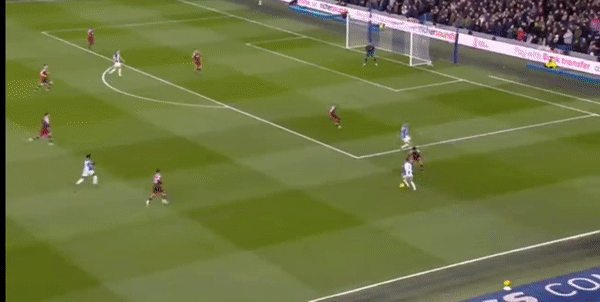Brighton under De Zerbi: High risk, high reward.
Brighton under Graham Potter were an exciting team, but De Zerbi's tactics have made them an even bigger force.
Graham Potter’s Brighton were a tactically exciting team, growing as a club with a reputation for bringing in quality talent at low prices, raising their stocks, and aiding their development as players.
Tony Bloom couldn’t have picked a better replacement in Robert De Zerbi, who has proven to be a special tactician. While Potter was a tactically flexible coach, using different approaches every week, De Zerbi has used the foundation Potter built to create a stable system and set-up emphasizing possession and verticality. He is a manager who takes so many risks with his interesting pressing structures and attacking patterns but is also reaping the benefits that come along with it.
Here, I try to break down De Zerbi at Brighton, appreciating what he has introduced into the side.
The System: 4-2-3-1
Starting his tenure with Potter’s 3-4-2-1, De Zerbi’s best success came when he switched to a 4-2-3-1, and since then he’s never looked back. Obviously, formations are fluid, but Brighton’s defensive shape mostly starts in a 4-2-3-1/4-4-2 shape. Their press is intense and aggressive, using a structure that keeps changing- sometimes the forwards will press the fullbacks, and other times they press the outside centre-backs, while the midfielders will ensure compactness in the centre with constant overloads, a key trait of a De Zerbi side. It’s a risky approach and can leave gaps in exploitable areas, but if done correctly, Brighton can immediately win the ball and progress the ball up the pitch.

However, Brighton have the necessary profiles and personnel at the back, comprising commanding and technical defenders like Estupiñán, Dunk, Webster, and Colwill. Estupiñán and Lamptey are an excellent duo, running their respective flanks, capable of staying high and wide as well as inverting into midfield. This versatility adds a layer of unpredictability to their build-up, as well as compactness in the structure. In front of goal is Robert Sanchez, a keeper that is great on the ball, but also senses danger and comes off his line whenever necessary (although, in recent weeks, Jason Steele has become a starter).
The ball-winning, though, comes from the excellent midfield duo of Caicedo and Mac Allister. An excellent blend of technical ability, progression, and press resistance, both midfielders do an excellent job of reading the game, with the former capable of shutting down any potential danger. While there is plenty of open space to defend, Brighton are willing to take the risks to build their attacks and have the required players to defend that open space.
Baiting the press
Without a doubt, the most unique quality of this Brighton side is ‘baiting the press’. Instead of directly playing through an opposition’s press, they lull the opposing team into a false sense of security. The center-backs receive the ball deeper, almost next to the goalkeeper, inviting the forwards to press. Once a pressing trigger is activated, the fullbacks invert next to the midfield, creating triangles and passing lanes to ensure simple 1-2 passes to build play. These passing actions are short and rapid, and Brighton are out of the first phase very quickly by inviting teams to press.

When playing out from the back as Brighton do, their centre-backs sit back, whilst the fullbacks will invert next to the midfield pivot, as I have stated. Their shape often resembles a 2-4-4. With the midfielders, fullbacks, and centre-backs in close proximity, Brighton can play quick short passes, and once they drag the opposition players out of position, they can play vertical, progressive passes in the open space behind, into the final third.
MacAllister and Moises Caicedo’s press resistance are vital in this aspect, being able to carry the ball and escape the pressure of the opposition players to progress play, is essential to this team.
Here’s a lovely clip that explains this very well. MacAllister’s movement is essential in creating those quick passes and triangles, and ‘fooling’ the opposition creates space for Brighton to progress the ball into the final third.

Brighton’s approach of build-up is evidently risky, as displayed by the clip below, but if done right, they reap the benefits which lead to quick attacking and transitional play.
Here, it seems like Brighton’s scheme almost collapses when Caicedo quickly rushes in to collect the ball on the half-turn, evading imminent pressure from West Ham. The turn is so smooth and clean that it opens up more space for Mac Allister to receive the ball and drive forward. De Zerbi’s imprints and vision are clear, but the quality at his disposal (not world-class) also aids him in implementing his principles.
Attacking principles, elite positional play
Polished positional play excites me, and Brighton’s attacking principles include exactly that. After moving out of the first and second phases, De Zerbi loves vertical and risky passes into open space to create transitions, through which Brighton will try to score.
In settled play, Brighton set up in a 2-3-5/3-2-5 in the final third. The interchanges of play are fluid, and players are aware of which spaces to move into. If the winger stays high and wide, there will be a midfielder in the half-space. Once the winger cuts in, the fullback or even one of the midfielders will keep width.
Here’s an example of that, Solly March stays high and wide, but once he cuts in Gross keeps the width for him on the right.
The fullbacks don’t just stay high and wide, they’re also capable of inverting into midfield. If Gross operates as the right-back, he usually inverts alongside Caicedo and MacAllister. If Veltman starts, he keeps the width but also adds a bit of unpredictability to Brighton’s build-up, dropping back as a third centre-back. This sounds very similar to Manchester City’s build-up, where Rico Lewis inverts if he plays, whilst Walker will operate as the third centre-back if he plays.

It’s only fair that I touch upon some of the quality at Brighton’s disposal. Suffering from striker issues at the start, Brighton seemed to have found some solution in the form of Evan Ferguson. Blessed with physicality and ball-striking, Ferguson also possesses a nice all-round game- he holds up the ball quite well to create space for others to run into, and his dribbling and passing are top-notch for a striker.
His assist here is one of my favourites, dropping deep and slotting in a clever through ball to March, who produces a calm finish.
Trossard, now at Arsenal, was used in a centre-forward role in addition to playing on the left, thanks to his qualities of hold-up, positioning, and technical security. Mitoma, his understudy, has made the left-wing role his own. He can stay high and wide to beat his man on the outside, but he’s just as deadly when cutting inside. His shot power and placement are great, and he also possesses the lovely trait of ‘pausa’, allowing him to combine with the likes of Caicedo and Estupiñán. He doesn’t have the lightning pace of someone like Mbappe, but his clever feints, trickery, and intelligence allow him to get past defenders with ease.
Solly March is one of Brighton’s most improved players- in addition to his crossing, there’s been a tremendous improvement in his technique and ability to beat players. He’s also chipped in with numerous goals, cutting in with ferocious strikes.
Solly March & Kaoru Mitoma both rank in the top 10 players for dribbles completed since October.
Caicedo and MacAllister are a fantastic blend of physicality, technique, and versatility (both can play as an 8 or 6). They combine super well with surrounding players to beat the press and have elite spatial awareness. MacAllister’s profile is akin to that of Ilkay Gundogan, possessing a low centre of gravity that makes him press-resistant, and box movement that’s influential in the final third. Caicedo is a master in the first and second phase of build-up. He can circulate and keep the ball well, but also play risky passes that progress the ball up the pitch. He’s elite on the half-turn and is always scanning, planning his next move in advance. This allows him to roam and sweep up any potential danger, excelling in ground duels.


The front 5 allows Brighton to outnumber opposition backlines, and they’re also willing to have 6 men in the box. It’s why they’re much more deadly in front of goal, and why they create so much.
The ideal balance
Robert De Zerbi’s philosophy of high-risk, high-reward, intrigues me. The combination of stringing passes to keep possession carefully, and the quick counters that stem from risky through balls and long passes from their midfielders and defenders, is an exciting prospect to me. Their method of creating solutions relies on individual ability, perfection, and risk-taking. It’s art-like, watching players move into spaces left by others, combining with teammates to the highest level, forming a synergy that only grows with each game.
If done incorrectly, Brighton can get exposed, but if executed right, they get favourable results. Risk. Reward.
It’s this very principle that makes me appreciate De Zerbi as a coach even more, and it’s something that has real-life value to it. Failures and setbacks will come and go, but without risk, there is zero progress and gain.










